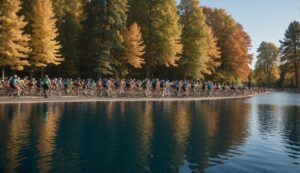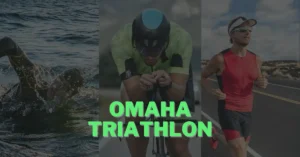📦 FREE Shipping
Best Bike for a Triathlon: Your Speed Machine for Race Day 2024!

Selecting the right bike for a triathlon is a decision that can significantly impact my performance. You might wonder: What is the best Bike for a Triathlon?
Triathlon bikes are engineered with a focus on aerodynamics and speed to assist me throughout the cycling portion of the race. Whether it’s a sprint distance or a full Ironman, the bike I choose needs to complement my riding style and race goals. It’s about finding the perfect synergy between me and the machine to shave off precious seconds.

Having observed the latest triathlon bikes of 2023, I’m intrigued by the advancements in technology and design that cater specifically to triathletes’ needs. These bikes offer a range of features such as optimized frame geometry and integrated componentry, all intended to enhance aerodynamic efficiency. Brands like Ventum, Argon, and Cervelo are leading the charge with bikes that push the boundaries of what’s possible in triathlon cycling.
As I look ahead, I’m also excited about the new releases anticipated for 2024. Innovations in the triathlon bike market such as adjustable aero-optimization and varied drivetrain options suggest that the scope for personalization and performance gains is broadening. It’s not just about the bike’s capabilities; it’s how those capabilities can be fine-tuned to meet my individual demands on the course. Embracing the latest in triathlon bike technology may just be the edge I need for my next race.
Choosing Your Triathlon Bike
In my triathlon journey, selecting the right bike made a significant impact on my performance and comfort. Here’s how to navigate this crucial choice.
Understanding Bike Categories
When I first looked into triathlon bikes, I realized they’re specifically designed for triathlons, differentiating them from typical road bikes. Their aerodynamic geometry is tailored to maximize efficiency and speed. For triathlons, road bikes can serve well for beginners, but for a serious competitive edge, invest in a triathlon bike. They emphasize a more aggressive posture and aerodynamics.
Key Components of a Triathlon Bike
My triathlon bike is the essence of precision and adaptability. The key features include:
- Aerodynamics: The frame design, deep-section wheels, and wing-like handlebars are there to slice through the wind.
- Adjustability: A good triathlon bike offers extensive options to tweak the seat position and handlebar height for optimal comfort and efficiency.
- Comfort: Despite a focus on speed, a well-chosen triathlon bike doesn’t compromise on comfort, as it can significantly affect my endurance and performance.

Finding the Perfect Fit
I learned that bike fit is not just about height; it’s about making the bike an extension of my body. Here are the factors I consider:
- Body Measurements: It’s vital to start with accurate body measurements to find a frame that suits my height and limb lengths.
- Riding Style: I assess my own riding style to make sure the bike complements it.
- Test Rides: I always take multiple bikes out for test rides to gauge the feel and comfort each one offers.
By focusing on these aspects, I found a bike that not only complements my racing style but also keeps me eager to get on the saddle for the next training or race day.
Advanced Bike Features and Technologies

In the quest to achieve the perfect harmony between rider and machine, I’m continually amazed by the advanced bike features and technologies available today.
Innovative Frame Designs
My focus is often drawn to the heart of the bike: the frame. It’s here where the magic starts with carbon fiber construction leading the charge. This material is not just lightweight; it’s also supremely stiff, ensuring that every ounce of my power is translated into forward motion. Engineers have sculpted these frames for maximum aerodynamics, targeting reduced drag with every curve and cutaway, and they’ve done so without sacrificing the frame’s stability or my comfort.
Integration and Storage Solutions
The genius of modern triathlon bikes lies in their attention to detail, especially when it comes to integration and storage solutions. My bike serves not just as a ride, but also a carrier for my nutritional needs and mechanical essentials. With integrated storage systems in the frame or behind the seat, my supplies are conveniently stowed away, and the aero bars are sleekly designed to cut through the wind – all without affecting the bike’s aerodynamics.
Cutting-Edge Gear Shifting
Electronic shifting has completely transformed my experience. No longer am I constrained by cables that stretch and wear; my gear shifts are now quick, precise, and consistent regardless of the conditions. With a simple push of a button, I can change gears with minimal effort. This technology integrates seamlessly with the overall design ethos, further enhancing the bike’s performance and my own efficiency during a race.
Optimizing Performance and Comfort
In triathlon cycling, every adjustment to my bike is a crucial step toward a blend of speed and enduring comfort. Let’s explore how I finely tune these elements for the best ride possible.
Aerodynamic Efficiency and Speed
To sustain high speeds with less effort, aerodynamic efficiency is key. I ensure that my handlebars and aero bars are adjusted to an aerodynamic position, which reduces drag. This setup means I can slice through the air faster and with more efficiency. Comfort doesn’t take a back seat here—I make certain that the bars are reachable without straining, allowing me to maintain this position comfortably throughout my race.
Engineering for Rider Comfort
The right saddle can make a world of difference. I look for a saddle that supports my sit bones appropriately, relieving pressure on soft tissues for a more comfortable ride. Adjusting the saddle height and angle for a smooth pedal stroke helps me avoid muscle strain and fatigue. Plus, ensuring that my brake levers are positioned correctly makes it easy to remain in control while I focus on the road ahead.
Weight and Stiffness Balance
I find the perfect balance between a lightweight frame and the right amount of stiffness. A lighter bike improves my acceleration and climbing performance, yet too much flex can sap power from my pedal strokes. Carbon fiber offers the stiffness I need without piling on weight, translating my energy directly into speed. On the other hand, aluminum is a more cost-effective alternative that still performs admirably, albeit with a slight increase in weight and a less responsive feel.
Selecting the Right Brand and Model
When I’m looking for the perfect triathlon bike, I consider two main criteria: the brand’s reputation and the model’s capability to match my racing needs and budget.
Top Triathlon Bike Brands
In my experience, several brands consistently lead the pack for the best triathlon bikes. Here’s a look at the cream of the crop as of 2023:
- Canyon: Known for the formidable Canyon Speedmax, which blends aerodynamics with rider comfort.
- Trek: Their Trek Speed Concept SLR 7 Gen 3 is revered for being a technological marvel, pushing the performance envelope.
- Specialized: A brand synonymous with innovation, often favored by professionals.
- Felt: Offers durable and well-engineered options, a solid choice for any level of competitor.
- Scott: The Scott Plasma 6, a name that often surfaces in conversations about top-tier triathlon bikes for its cutting-edge features.
Budget-Friendly vs. High-End Models
Deciding between affordable and premium bikes is always a challenge:
- Affordable: An affordable model like the Argon E-117 Tri Disc can provide tremendous value. It’s crucial to find a bike that performs well without breaking the bank.
- High-End: If budget is less of a concern, premium models provide advancements in aerodynamics, weight, and comfort. Expect prices to reflect the high-quality materials and research that go into these bikes.
Selecting a bike is about finding the stride between price and performance. I’m dedicated to choosing a brand and model that boosts my speed and confidence in every race.
Frequently Asked Questions about Bike for a Triathlon
I’m thrilled to share some common questions and solid insights to help anyone excited about triathlon bikes!
What are the best entry-level bikes for triathlon newbies?
For those starting out, brands like Felt, Specialized, and Trek offer entry-level triathlon bikes that balance cost and performance, giving you a competitive edge without breaking the bank.
How does a road bike compare to a triathlon bike for my first race?
A road bike often has a more relaxed geometry that’s versatile for various terrains and comfort over long distances. Triathlon bikes are engineered for speed and aerodynamics in a straight line, specifically for racing.
Where can I find triathlon bikes that offer great value?
Great value triathlon bikes can be found at specialty bike shops or through online retailers. Sometimes, previous season models can offer incredible value for the technology they provide.
What are the key features to look for in a triathlon bike?
Look for a bike with aero bars, an aggressive, aerodynamic frame design, and components like aero wheels and integrated storage that can shave seconds off your race time.
Is it possible to compete in a triathlon with a regular road bike?
Absolutely! Many triathletes start with a road bike. Just ensure it’s fitted correctly to you, and consider adding clip-on aero bars to improve your aerodynamic positioning.
How do I determine the correct size of a triathlon bike for me?
Bike sizing can be complex, but generally depends on your height and inseam length. It’s best to get a professional bike fit to ensure optimal comfort, power, and aerodynamics.
Is your question about the best Bike for a Triathlon answered? Leave me a comment and make sure to also check out Triathlon Equipment and What is an Ironman Run.





